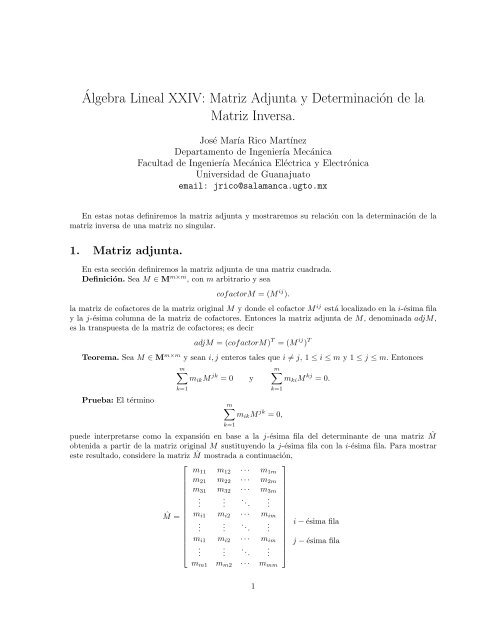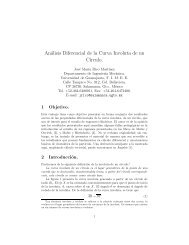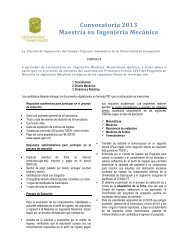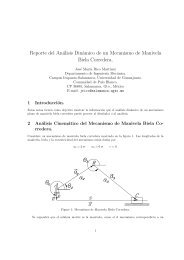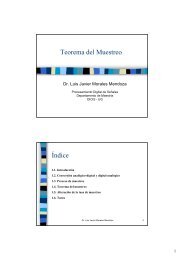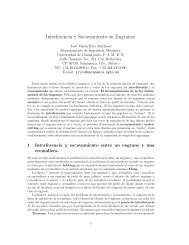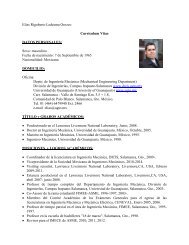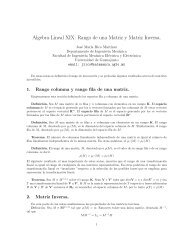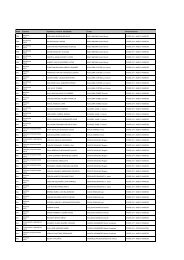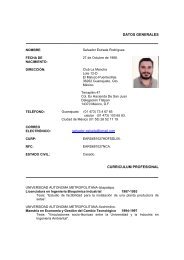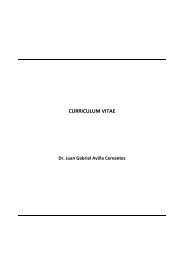Matriz Adjunta y Determinación de la Matriz Inversa.
Matriz Adjunta y Determinación de la Matriz Inversa.
Matriz Adjunta y Determinación de la Matriz Inversa.
Create successful ePaper yourself
Turn your PDF publications into a flip-book with our unique Google optimized e-Paper software.
Álgebra Lineal XXIV: <strong>Matriz</strong> <strong>Adjunta</strong> y Determinación <strong>de</strong> <strong>la</strong><br />
<strong>Matriz</strong> <strong>Inversa</strong>.<br />
José María Rico Martínez<br />
Departamento <strong>de</strong> Ingeniería Mecánica<br />
Facultad <strong>de</strong> Ingeniería Mecánica Eléctrica y Electrónica<br />
Universidad <strong>de</strong> Guanajuato<br />
email: jrico@sa<strong>la</strong>manca.ugto.mx<br />
En estas notas <strong>de</strong>finiremos <strong>la</strong> matriz adjunta y mostraremos su re<strong>la</strong>ción con <strong>la</strong> <strong>de</strong>terminación <strong>de</strong> <strong>la</strong><br />
matriz inversa <strong>de</strong> una matriz no singu<strong>la</strong>r.<br />
1. <strong>Matriz</strong> adjunta.<br />
En esta sección <strong>de</strong>finiremos <strong>la</strong> matriz adjunta <strong>de</strong> una matriz cuadrada.<br />
Definición. Sea M ∈ M m×m ,conm arbitrario y sea<br />
cofactorM =(M ij ).<br />
<strong>la</strong> matriz <strong>de</strong> cofactores <strong>de</strong> <strong>la</strong> matriz original M y don<strong>de</strong> el cofactor M ij está localizadoen<strong>la</strong>i-ésima fi<strong>la</strong><br />
y<strong>la</strong>j-ésima columna <strong>de</strong> <strong>la</strong> matriz <strong>de</strong> cofactores. Entonces <strong>la</strong> matriz adjunta <strong>de</strong> M, <strong>de</strong>nominada adjM,<br />
es <strong>la</strong> transpuesta <strong>de</strong> <strong>la</strong> matriz <strong>de</strong> cofactores; es <strong>de</strong>cir<br />
adjM =(cofactorM) T =(M ij ) T<br />
Teorema. Sea M ∈ M m×m yseani, j enteros tales que i ≠ j, 1≤ i ≤ m y1≤ j ≤ m. Entonces<br />
m∑<br />
m∑<br />
m ik M jk =0 y m ki M kj =0.<br />
Prueba: El término<br />
k=1<br />
k=1<br />
m∑<br />
m ik M jk =0,<br />
k=1<br />
pue<strong>de</strong> interpretarse como <strong>la</strong> expansión en base a <strong>la</strong> j-ésima fi<strong>la</strong> <strong>de</strong>l <strong>de</strong>terminante <strong>de</strong> una matriz ˆM<br />
obtenida a partir <strong>de</strong> <strong>la</strong> matriz original M sustituyendo <strong>la</strong> j-ésima fi<strong>la</strong> con <strong>la</strong> i-ésima fi<strong>la</strong>. Para mostrar<br />
este resultado, consi<strong>de</strong>re <strong>la</strong> matriz ˆM mostrada a continuación,<br />
⎡<br />
⎤<br />
m 11 m 12 ··· m 1m<br />
m 21 m 22 ··· m 2m<br />
m 31 m 32 ··· m 3m<br />
. .<br />
. . . ..<br />
. .<br />
ˆM =<br />
m i1 m i2 ··· m im<br />
. . . .. i − ésima fi<strong>la</strong><br />
.<br />
m i1 m i2 ··· m im<br />
j − ésima fi<strong>la</strong><br />
⎢ . .<br />
⎣<br />
.<br />
. . ..<br />
. ⎥<br />
. ⎦<br />
m m1 m m2 ··· m mm<br />
1
Note que ˆM jk = M jk .A<strong>de</strong>más, puesto que ˆM tiene dos fi<strong>la</strong>s iguales <strong>de</strong>t ˆM =0,porlotanto<br />
S =<br />
m∑<br />
m ik M jk = <strong>de</strong>t ˆM = <strong>de</strong>t ˆM T =0.<br />
k=1<br />
Un procedimiento semejante permite probar el valor <strong>de</strong> <strong>la</strong> otra sumatoria.<br />
Teorema. Sea M ∈ M m×m .Lainversa<strong>de</strong>M <strong>de</strong>notada por M −1 está dada por<br />
M −1 = adjM<br />
<strong>de</strong>tM<br />
Prueba: Consi<strong>de</strong>re el producto<br />
N = M adjM<br />
<strong>de</strong>tM<br />
Entonces, los elementos <strong>de</strong> <strong>la</strong> matriz N están dados por<br />
1. Elementos en <strong>la</strong> diagonal,<br />
n ii =<br />
n∑<br />
j=1<br />
m ij<br />
M ij<br />
<strong>de</strong>tM = 1<br />
<strong>de</strong>tM<br />
m∑<br />
m ij M ij =1 ∀ 1 ≤ i ≤ m.<br />
j=1<br />
2. Elementos fuera <strong>de</strong> <strong>la</strong> diagonal,<br />
n ij =<br />
n∑<br />
k=1<br />
m ij<br />
M ij<br />
<strong>de</strong>tM = 1<br />
<strong>de</strong>tM<br />
m∑<br />
m ij M ij =0 ∀ 1 ≤ i ≤ m, don<strong>de</strong> i ≠ j.<br />
j=1<br />
De aquí que,<br />
Finalmente<br />
N = M adjM<br />
<strong>de</strong>tM = I m<br />
M −1 = adjM<br />
<strong>de</strong>tM .<br />
2. Problemas Resueltos.<br />
Problema 1. Suponga que <strong>la</strong> matriz M está dadapor<br />
⎡<br />
M = ⎣ 1 3 −1 ⎤<br />
2 −1 3 ⎦<br />
1 2 −3<br />
Determine <strong>la</strong> inversa <strong>de</strong> esta matriz mediante el método<strong>de</strong><strong>la</strong>matrizadjunta.<br />
Solución. De acuerdo con el método, se <strong>de</strong>be obtener primero <strong>la</strong> matriz <strong>de</strong> menores <strong>de</strong> <strong>la</strong> matriz M,<br />
⎡<br />
⎤<br />
−3 −3 5<br />
menorM = ⎣ −7 −4 5 ⎦<br />
8 5 −7<br />
La matriz <strong>de</strong> cofactores <strong>de</strong> M está dadapor<br />
⎡<br />
cofactorM = ⎣ −3 3 5 ⎤<br />
7 −4 −5 ⎦<br />
8 −5 −7<br />
2
Finalmente, <strong>la</strong> matriz inversa <strong>de</strong> M, dada por M −1 ,estádadapor<br />
M −1 = (cofactorM)<br />
| M |<br />
don<strong>de</strong> | M |= 3,porlotanto<br />
⎡<br />
⎣ −3 3 5 ⎤<br />
7 −4 −5 ⎦<br />
M −1 8 −5 −7<br />
=<br />
3<br />
T<br />
⎡<br />
= 1 ⎣ −3 7 8 ⎤<br />
3 −4 −5 ⎦<br />
3<br />
5 −5 −7<br />
3. Problemas Propuestos.<br />
Problema 1. Consi<strong>de</strong>re <strong>la</strong> matriz <strong>de</strong>l problema propuesto 3, <strong>de</strong> <strong>la</strong>s notas Álgebra Lineal XIX:<br />
Rango <strong>de</strong> una <strong>Matriz</strong> y <strong>Matriz</strong> <strong>Inversa</strong>, dada por<br />
⎡<br />
1 −2 2 ⎤<br />
M 1 = ⎣ 3 1 0 ⎦<br />
−1 2 1<br />
Determine su matriz inversa.<br />
3


